Highlight
- Co-occurrence of two or more high-risk cytogenetic abnormalities (HRCAs) significantly worsens progression-free and overall survival in multiple myeloma (MM).
- This adverse prognostic impact is consistent across newly diagnosed (NDMM) and relapsed/refractory (RRMM) settings as well as a variety of treatment modalities.
- A federated meta-analysis of 24 randomized controlled trials with 13,926 MM patients confirms these findings using a standardized cytogenetic algorithm.
- Recognition of ‘‘double-hit’’ cytogenetic profiles enables more precise risk stratification and informs the development of novel therapeutic approaches.
Study Background and Disease Burden
Multiple myeloma (MM) is a malignant plasma cell disorder characterized by clonal proliferation within the bone marrow. Despite advances in therapy that have extended survival substantially, outcomes remain highly heterogeneous, underpinned in part by cytogenetic heterogeneity. Certain cytogenetic abnormalities are recognized as high-risk features that portend poor prognosis. However, their concurrent presence and combined impact on outcomes traditionally lack standardized assessment. Reliable identification of high-risk disease subsets is crucial to optimize risk-adapted treatment strategies, address unmet clinical needs, and guide drug development.
Study Design
This study performed a systematic review and pooled meta-analysis of randomized controlled trials (RCTs) conducted between January 2000 and December 2021, focusing on MM patients subjected to cytogenetic testing for high-risk abnormalities (HRCAs). The eligible HRCAs included abnormalities such as del(17p), t(4;14), t(14;16), and others recognized in MM risk stratification.
Researchers employed a novel federated analysis approach whereby study groups applied a centrally provided algorithm locally to their trial data, classifying patients into single-hit (one HRCA) and double-hit (two or more HRCAs) subgroups. Outcomes assessed were progression-free survival (PFS) and overall survival (OS), with hazard ratios (HRs) calculated for each subgroup across NDMM and RRMM populations and different treatment regimens. Random-effects meta-analytic models aggregated results, and subgroup analyses scrutinized heterogeneity relating to transplant eligibility and disease status.
Key Findings
The analysis incorporated data from 24 RCTs encompassing 13,926 patients with a median age of 66.5 years, of whom 56.5% were male. The key findings include:
– Patients harboring two or more HRCAs (double-hit) exhibited a markedly higher risk of progression or death compared to those with no or single HRCAs. Specifically, the pooled HR for PFS was 2.28 (95% CI, 2.05–2.54) for double-hit versus 1.51 (95% CI, 1.38–1.65) for single-hit patients.
– Overall survival was similarly affected, with double-hit patients showing an HR of 2.94 (95% CI, 2.49–3.47) versus 1.69 (95% CI, 1.52–1.88) for single-hit.
– These associations held consistently for studies initiated since 2015, supporting their robustness amid evolving therapeutic standards (≥two HRCAs PFS HR 2.39, OS HR 3.10).
– Both newly diagnosed (NDMM) and relapsed/refractory MM (RRMM) patients followed this pattern, indicating the prognostic value of co-occurring HRCAs is independent of disease stage or treatment history.
– Expected heterogeneity was noted based on transplant eligibility and relapse/refractory status, underscoring the importance of clinical context.
Expert Commentary
This comprehensive meta-analysis provides the most definitive evidence to date that co-occurrence of multiple high-risk cytogenetic abnormalities profoundly worsens MM prognosis, surpassing the impact of isolated abnormalities. The utilization of a federated analysis model allowed standardized and reproducible assessment across heterogeneous datasets, overcoming barriers of data sharing and variability in cytogenetic testing.
From a biological standpoint, the ‘‘double-hit’’ status plausibly reflects additive or synergistic oncogenic mechanisms that accelerate disease progression and therapy resistance. Clinically, these findings validate the need for integrating combined cytogenetic profiling into routine diagnostics and underscore the potential for more aggressive or novel therapeutic approaches targeted to double-hit myeloma.
Limitations include variability in detection methods, incomplete cytogenetic panels in some trials, and the observational nature of association analyses precluding direct causality inference. Nonetheless, the consistency across multiple large trials and patient subgroups strengthens clinical relevance.
Conclusion
The co-occurrence of two or more high-risk cytogenetic abnormalities in multiple myeloma identifies a subgroup of patients with substantially inferior progression-free and overall survival, irrespective of disease stage and treatment modality. This stratification enables more precise prognostication and highlights a high unmet need population ripe for tailored therapeutic innovation. Future clinical trials and treatment guidelines should incorporate double-hit cytogenetic status to optimize risk-adapted management and improve outcomes.
References
Kaiser MF, Sonneveld P, Cairns DA, Raab MS, San-Miguel Izquierdo J, Zhang R, Acosta J, Larocca A, Popat R, Li C, Baertsch MA, Brown SR, Lahuerta Palacios J, Gandhi AK, Macé S, Musto P, Yong K, Mai EK, Dubin F, Blade J, Capra A, Cook G, Bertsch U, Mateos MV, Boccadoro M, Jackson GH, Gutiérrez NC, Gay F, Weinhold N. Co-Occurrence of Cytogenetic Abnormalities and High-Risk Disease in Newly Diagnosed and Relapsed/Refractory Multiple Myeloma. J Clin Oncol. 2025 Aug 20;43(24):2679-2691. doi:10.1200/JCO-24-01253. Epub 2025 Feb 18. PMID: 39965171; PMCID: PMC12352566.
Rajkumar SV. Multiple myeloma: 2020 update on diagnosis, risk-stratification, and management. Am J Hematol. 2020 Nov;95(11):1366-1387. doi:10.1002/ajh.25938.
Kumar SK, Rajkumar V, Kyle RA, et al. Multiple myeloma. Nat Rev Dis Primers. 2017 Jan 19;3:17046. doi:10.1038/nrdp.2017.46.


